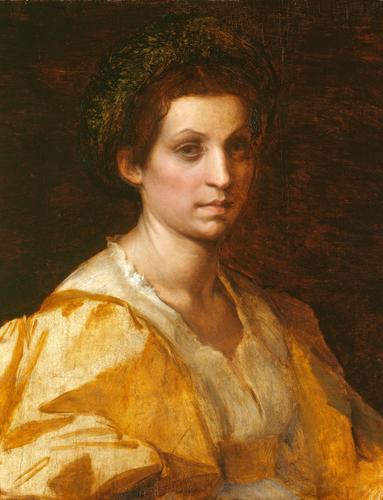-
1 of 253523 objects
Portrait of a Woman in Yellow c.1529-30
Oil on poplar panel | 64.3 x 50.1 x 1.7 cm (support, excluding additions) | RCIN 404427
-
Andrea del Sarto’s Portrait of a woman in yellow is unfinished and dates from the very end of the artist’s life: it is possible that his death from the plague prevented its completion. It provides a fascinating insight into a work-in-progress in a Renaissance studio.
The most finished area is the face with skin tones of a polished solidity, which contrast with the spontaneity of the sitter’s vibrant yellow dress. This is broadly indicated with the pale thin imprimatura still exposed in the area of the sleeve. For the forehead the first paint layer appears to have been sketchily and thinly applied, not as a flat tone but using a ‘wet-in-wet’ range of shadow and highlight. The left side of the face and neck was then worked up more fully with opaque flesh tones. The lower layers of her shirt and dress and the background were freely executed with a relatively broad brush. Sarto then indicated her sleeves and waistband with ochreous brushstrokes, even adjusting areas with his palm and fingers. The background is modulated from a warm dark red to brown and if completed may have suggested the sitter's shadow as in the background of the Portrait of Becuccio Bicchieraio (National Gallery of Scotland) c.1528.
The sitter was to have worn a green balzo or headdress, but it is simply sketched in and therefore hard to know whether leather or cloth was intended. The accomplished underdrawing is free and bold. Some lines are visible on the surface, for example the long, sweeping strokes giving the turn of her neck; other areas can be seen with infra-red reflectography. The construction of the features and smaller details (the strands of hair, the ornament on her balzo) were drawn in and then adjusted in the process of painting, often leading to small changes in position. It is likely that the artist was working from a detailed drawing, made from the life.
This work is more fully realised and powerful than the similarly unfinished portrait of c.1522 in the Staatliche Museen, Berlin, for which there is a detailed preparatory drawing. The sculptural relief of her skin tones and angular drapery have been compared to similarly unfinished passages of the same date for example the unfinished head of San Fedele in the Poppi altarpiece (Pitti Palace, Florence). The composition here is balanced and simple, without the distraction of hands, attributes or background. Characteristic of Sarto’s late work is the way in which the sitter emerges from the dark background, her features caught in intense light and flickering shadows. She fixes us with a heavy-lidded gaze, suggestive of melancholy and world-weariness. In fact her expression is enigmatic, but the concentration of her gaze is made more powerful by the contrast of her unyielding skin tones with the unfinished dress. The bravura of the brushwork here gives the portrait its immediacy since it gives the illusion that the artist has only stopped work to which he will return.
Catalogue entry adapted from The Art of Italy in the Royal Collection: Renaissance and Baroque, London, 2007Provenance
Possibly acquired by Charles II, Frederick Prince of Wales, or George III; first certainly recorded at Windsor Castle in the 1830s
-
Creator(s)
-
Medium and techniques
Oil on poplar panel
Measurements
64.3 x 50.1 x 1.7 cm (support, excluding additions)
65.7 x 50.3 x 1.7 cm (support, canvas/panel/stretcher external)
84.8 x 70.8 x 7.5 cm (frame, external)
Category
Object type(s)
